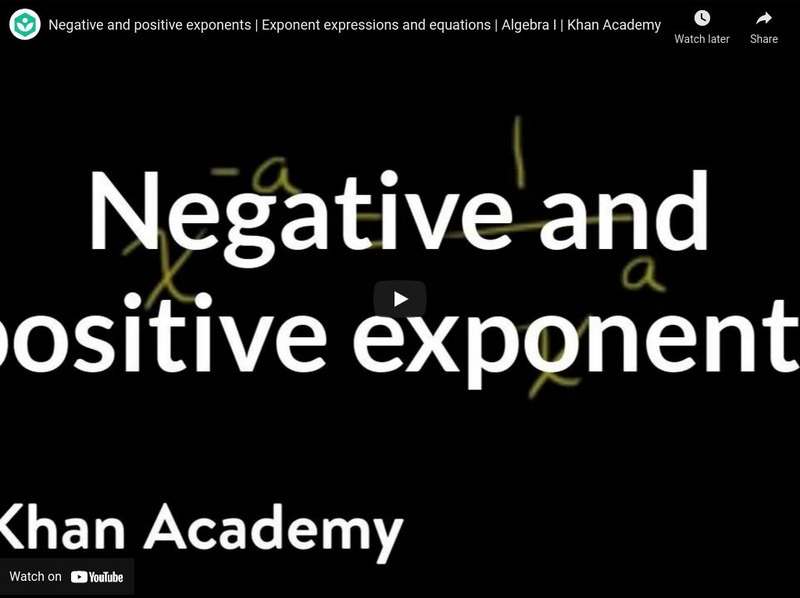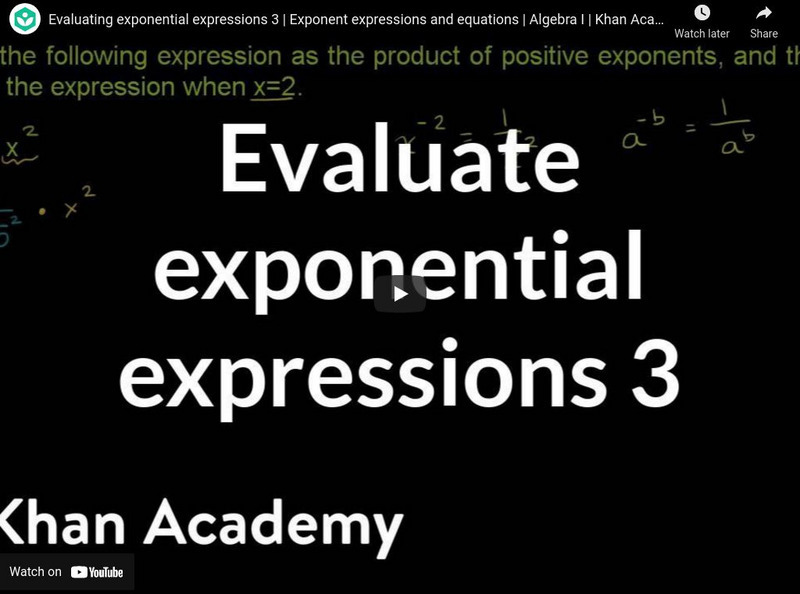Curated Video
Introduction to Scientific Notation: Writing and Converting Very Small Numbers
In this video, the teacher explains how to write very small numbers using scientific notation. They cover the concept of positive and negative exponents and demonstrate how to move the decimal point to the right or left accordingly. The...
Why U
Pre-Algebra 22 - Exponents of One, Zero, and Negative
Integer exponents greater than one represent the number of copies of the base which are multiplied together. But what if the exponent is one, zero or negative? Using the rules of adding and subtracting exponents, we can see what the...
Brian McLogan
Simplifying Expressions with Negative Exponents
👉 Learn about the rules of exponents. An exponent is a number which a number is raised to, to produce a power. It is the number of times which a number will multiply itself in a power. There are several rules used in evaluating...
Catalyst University
Limits of Exponentials and Sums of Exponentials
Limits of Exponentials and Sums of Exponentials
Brian McLogan
Multiplying in scientific notation with negative exponents
👉 Learn how to multiply numbers written in scientific notations. Scientific notation is a convenient way of writing very large or very small numbers. A number written in scientific notation is of the form a * 10^n where a is the first...
Brian McLogan
Learn how to use the chain rule in calculus
👉 Learn how to find the derivative of a function using the chain rule. The derivative of a function, y = f(x), is the measure of the rate of change of the function, y, with respect to the variable x. The process of finding the derivative...
Why U
Pre-Algebra 25 - Simplifying Divided Exponential Expressions
Exponential expressions with divided terms can be simplified using the rules for subtracting exponents.
Brian McLogan
Using multiple properties of exponents simplify the expression
👉 Learn how to simplify expressions using the power rule and the negative exponent rule of exponents. When several terms of an expression is raised to an exponent outside the parenthesis, the exponent is distributed over the individual...
Curated Video
Zero, Negative & Properties of Exponents
In this video lesson we will review properties of exponents. This video is intended as a review of previously learned concepts in Grade 8 for Algebra 1 students beginning a unit on Exponential Functions and Sequences. We will...
Brian McLogan
Simplify monomials using law of exponents
👉 Learn how to simplify expressions using the power rule of exponents. When several terms of an expression is raised to an exponent outside the parenthesis, the exponent is distributed over the individual terms in the expression and the...
Brian McLogan
Why Do the Negative Exponent Rules Work
👉 Learn about the rules of exponents. An exponent is a number which a number is raised to, to produce a power. It is the number of times which a number will multiply itself in a power. There are several rules used in evaluating...
Curated Video
Simplifying Intermediate Expressions with Zero and Negative Exponents
In this video, the teacher explains how to simplify intermediate level expressions involving zero and negative exponents. They discuss the rule that any number raised to the 0 exponent is equal to 1, and any number raised to a negative...
Curated Video
Simplifying Expressions with Negative Exponents
In this video, students learn how to simplify expressions involving negative exponents by applying exponent rules. The teacher explains that any base raised to a negative exponent is equal to 1 divided by that base raised to the positive...
Curated Video
Dividing Exponential Expressions
In this video, the teacher explains how to divide exponential expressions with the same base by using exponent rules. They demonstrate two methods: visualizing the expansion and subtracting the exponents.
Curated Video
Graphing Exponential Functions
This video explains how to graph exponential functions by modeling cutting a string. It demonstrates the concept of exponential decay and shows how the length of the string decreases exponentially with each cut. The video also explains...
Curated OER
How Do You Convert From Decimal Notation to Scientific Notation?
The instructor demonstrates how to convert a number written in decimal form to scientific notation. An example is given for a number with a positive exponent and an example is given for a number with a negative exponent.
Curated OER
How Do You Convert From Scientific Notation to Decimal Notation?
The instructor demonstrates how to convert a number written in scientific notation to a decimal number. An example is given for a number with a positive exponent, and an example is given for a number with a negative exponent.
Curated OER
How Do You Convert From Decimal Notation to Scientific Notation?
The instructor demonstrates how to convert a number written in decimal form to scientific notation. An example is given for a number with a positive exponent and an example is given for a number with a negative exponent.
Curated OER
How Do You Convert From Scientific Notation to Decimal Notation?
The instructor demonstrates how to convert a number written in scientific notation to a decimal number. An example is given for a number with a positive exponent, and an example is given for a number with a negative exponent.
Curated OER
What Do You Do With a Negative Exponent?
Just watch this video for a very thorough explanation, step-by-step, on how to work with negative exponents. The instructor explains how it is possible that negative exponents and inverses and fractions are connected in this situation....
Khan Academy
Khan Academy: Algebra: Exponent Properties 7
Video simplifying an algebraic expression using various rules of exponents. [4:51]
Khan Academy
Khan Academy: Algebra: Negative and Positive Exponents
Video simplifying an algebraic expression with negative exponents and then evaluating it when x equals 2. [2:19]
Khan Academy
Khan Academy: Algebra: Evaluating Exponential Expressions 3
Video evaluating an exponential expression using the order of operations. Includes negative exponents. [4:26]








